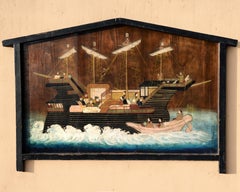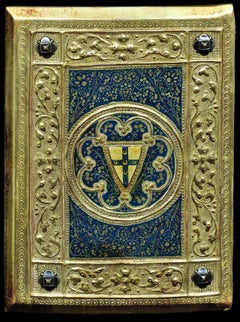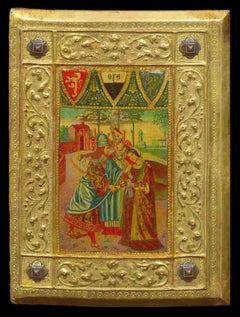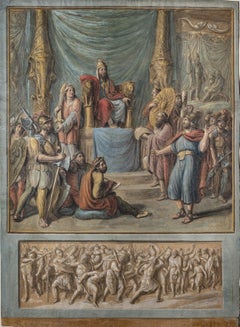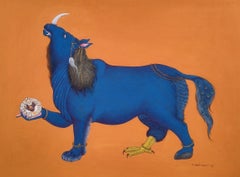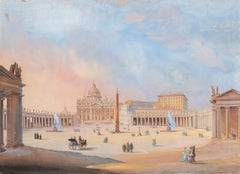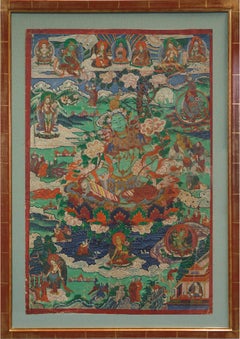Tempera Figurative Paintings
to
5
14
3
12
5
9
8
4
7
4
1
1
Overall Height
to
Overall Width
to
2
2
10
4
4
3
3
1
1
1
1
1
1
1
1
1
1
1
1
1
13
17
202
226
3
2
17
27
27
17
15
11
29
5
2
1
1,390
2,146
2,002
1,012
984
Period: 19th Century
Medium: Tempera
Large Japanese Wood Board Ema Namban Depicting a Portuguese Ship Edo period
Located in Stockholm, SE
An Ema is a votive plaque people hang in a "dedication area", at a Shinto shrine, with their wish to the gods. Wishes usually would revolve around health, love, career, prosperity, a...
Category
Mid-19th Century Realist Tempera Figurative Paintings
Materials
Wood, Tempera, Egg Tempera, Wood Panel
Painted Wood Tavolette Book Cover Binding in the Biccherna Style Siena Tuscany
Located in Sutton Poyntz, Dorset
Icilio Federico Joni.
Italian ( b.1866 - d.1946 ).
Painted Gesso, Gilt and Wood Tavolette Book Cover Binding in the Sienese Biccherna Style
Book Cover size 11 inches x 8.1 inches ( 28cm x 20.5cm ).
Frame size 16 inches x 13 inches ( 40.5cm x 33cm ).
Available for sale; this painted gesso and gilt “tavolette” wooden book cover in the Biccherna style is by Icilio Federico Joni.
The book cover is mounted and supplied in a contemporary black Tulip Wood frame (which is shown in these photographs) which is glazed with non-reflective Tru Vue UltraVue® UV70 glass. The wooden book cover is curved and float mounted giving a wonderful 3D depth to its presentation.
The gesso and painted surfaces have benefitted from professional restoration which was performed on our instruction, supervision and approval.
This antique book cover is now in very good condition, commensurate with its age.
The frame presentation is new and in excellent condition. Combined, it wants for nothing and is supplied ready to hang and display.
The story of these panels and of their artist is fascinating, and begins in 13th century Siena:
The Biccherna was the person who held the position of Magistrate of Chancellery of Finance from the 13th to the 14th century for the republic and the city of Siena, in the Tuscany region of Italy. The records of that office were very important because Siena was one of the earliest and most significant banking centres in Italy, and indeed in Europe. It became the fashion to keep banking and taxation records of the region in large books with painted leather covers. These were originally made from wood and leather. In the competition to make these ever more prestigious the bindings and panels on the front and rear of the books were painted by the major artists of the day, such as Giovanni di Paolo. Many of these mainly secular covers are displayed in the Archives of the State of Siena located in the Palazzo Piccolmini.
The Gothic Revival of the 19th century occurred partly as a reaction against the progress of industrialisation in Europe generally. It was however greatly affected by the unification of Italy in the second half of the 19th century. This led to the closure and downsizing of many religious institutions, which resulted in the dispersal of thousands of works of art dating from the Middle Ages and early Renaissance. Many aristocratic and bourgeois families struggled to pay debts or simply to make ends meet and so they sold off their private collections and family heirlooms. There was then an influx of goods into the antiques market which provided a great deal of work for Italy’s restorers and craftsmen, since many of these pieces were in need of cleaning, repair and, in keeping with the interventionist tastes of the times, radical restoration, before they could be sold on, often to foreign buyers. These early Italian works became so fashionable that demand soon outstripped supply. This in turn gave rise to a new type of artist-craftsman capable of turning out from scratch increasingly convincing reproductions, imitations and out-and-out fakes.
Siena naturally became the epicentre of this thriving cottage industry because of the extraordinary continuity there in traditional craft skills. This technical expertise had been handed down from generation to generation, and it was perhaps inevitable that a number of artists with real talent, the flair of commerce and a genuine love and understanding of antique Sienese art should adapt their skills to these new market conditions. Among these artists were Igino Gottardi, Alceo Dossena, Fulvio Corsini, Umberto Giunti...
Category
Late 19th Century Gothic Tempera Figurative Paintings
Materials
Gesso, Oil, Tempera, Wood Panel
Painted Wood Tavolette Book Cover Binding in the Biccherna Style Siena Tuscany
Located in Sutton Poyntz, Dorset
Icilio Federico Joni.
Italian ( b.1866 - d.1946 ).
Painted Gesso, Gilt and Wood Tavolette Book Cover Binding in the Sienese Biccherna Style
Book Cover size 11 inches x 8.1 inches ( 28cm x 20.5cm ).
Frame size 16 inches x 13 inches ( 40.5cm x 33cm ).
Available for sale; this painted gesso and gilt “tavolette” wooden book cover in the Biccherna style is by Icilio Federico Joni.
The book cover is mounted and supplied in a contemporary black Tulip Wood frame (which is shown in these photographs) which is glazed with non-reflective Tru Vue UltraVue® UV70 glass. The wooden book cover is curved and float mounted giving a wonderful 3D depth to its presentation.
The gesso and painted surfaces have benefitted from professional restoration which was performed on our instruction, supervision and approval.
This antique book cover is now in very good condition, commensurate with its age.
The frame presentation is new and in excellent condition. Combined, it wants for nothing and is supplied ready to hang and display.
The story of these panels and of their artist is fascinating, and begins in 13th century Siena:
The Biccherna was the person who held the position of Magistrate of Chancellery of Finance from the 13th to the 14th century for the republic and the city of Siena, in the Tuscany region of Italy. The records of that office were very important because Siena was one of the earliest and most significant banking centres in Italy, and indeed in Europe. It became the fashion to keep banking and taxation records of the region in large books with painted leather covers. These were originally made from wood and leather. In the competition to make these ever more prestigious the bindings and panels on the front and rear of the books were painted by the major artists of the day, such as Giovanni di Paolo. Many of these mainly secular covers are displayed in the Archives of the State of Siena located in the Palazzo Piccolmini.
The Gothic Revival of the 19th century occurred partly as a reaction against the progress of industrialisation in Europe generally. It was however greatly affected by the unification of Italy in the second half of the 19th century. This led to the closure and downsizing of many religious institutions, which resulted in the dispersal of thousands of works of art dating from the Middle Ages and early Renaissance. Many aristocratic and bourgeois families struggled to pay debts or simply to make ends meet and so they sold off their private collections and family heirlooms. There was then an influx of goods into the antiques market which provided a great deal of work for Italy’s restorers and craftsmen, since many of these pieces were in need of cleaning, repair and, in keeping with the interventionist tastes of the times, radical restoration, before they could be sold on, often to foreign buyers. These early Italian works became so fashionable that demand soon outstripped supply. This in turn gave rise to a new type of artist-craftsman capable of turning out from scratch increasingly convincing reproductions, imitations and out-and-out fakes.
Siena naturally became the epicentre of this thriving cottage industry because of the extraordinary continuity there in traditional craft skills. This technical expertise had been handed down from generation to generation, and it was perhaps inevitable that a number of artists with real talent, the flair of commerce and a genuine love and understanding of antique Sienese art should adapt their skills to these new market conditions. Among these artists were Igino Gottardi, Alceo Dossena, Fulvio Corsini, Umberto Giunti...
Category
Late 19th Century Gothic Tempera Figurative Paintings
Materials
Gesso, Oil, Tempera, Wood Panel
Neoclassical figurative tempera on paper with historical theme.
Located in Florence, IT
Measurements with frame: 87 x 69 cm
The Ademollian tempera, which can be dated roughly between the first and third decades of the 19th century, illustrates two episodes of war and mo...
Category
Early 19th Century Other Art Style Tempera Figurative Paintings
Materials
Paper, Tempera
Neoclassical figurative tempera on paper with a religious theme.
Located in Florence, IT
Measurements with frame: 87 x 69 cm
In this tempera dated between the second and third decade of the 19th century we find an iconographic design with a sacred character by neoclassic...
Category
Early 19th Century Other Art Style Tempera Figurative Paintings
Materials
Paper, Tempera
Carlo Grubacs(Venetian master)- Pair of 19th century Venice landscape paintings
By Carlo Grubacs
Located in Varmo, IT
Carlo Grubacs (Perasto 1801 - Venice 1870) - Venice, pair of views of Piazza S. Marco and the Piazzetta towards the Clock Tower.
19 x 24 cm without frame, 25 x 30 cm with frame.
An...
Category
Mid-19th Century Old Masters Tempera Figurative Paintings
Materials
Tempera, Paper
Carlo Grubacs(Venetian master)- Pair of 19th century Venice landscape paintings
By Carlo Grubacs
Located in Varmo, IT
Carlo Grubacs (Perasto 1801 - Venice 1870) - Venice, pair of views of Piazza S. Marco and the Basin towards the Riva degli Schiavoni.
11 x 16 cm without frame, 29.5 x 34.5 cm with f...
Category
Mid-19th Century Old Masters Tempera Figurative Paintings
Materials
Tempera, Paper
Vedutist Florentine painter - Late 19th century landscape painting - Pisa Tower
Located in Varmo, IT
Italian painter (late 19th century) - Pisa, bird's eye view with the Leaning Tower and the Campo dei Miracoli.
66 x 93 cm without frame, 78 x 105 cm with frame.
Antique tempera painting...
Category
Late 19th Century Realist Tempera Figurative Paintings
Materials
Paper, Tempera
Vedutist painter (Venetian school) - Early 19th century painting - View Venice
Located in Varmo, IT
Venetian painter (early 19th century) - Venice, view of the gardens with the Coffee House towards the Basilica of Santa Maria della Salute.
15 x 23 cm without frame, 22 x 30 cm with...
Category
Mid-19th Century Naturalistic Tempera Figurative Paintings
Materials
Paper, Tempera
Persian Illuminated Miniature with Two Figures Hunting in a Landscape
Located in Milwaukee, WI
The present illuminated page was once part of a larger manuscript, as evidenced by the tears along the right edge, illustrating a story from the Islamic world. The scene presents two figures in a landscape, one on horseback and another gesturing to a fallen deer. The stylization of the landscape shows influence from the Byzantine tradition of painting, with jagged rocks jutting into a golden sky. The page contains handwritten text on both sides, and is surrounded by gold illustrations of peacocks and a running deer.
11 x 6.5 inches, artwork
18.63 x 14 inches, frame
accompanied on the back with an image of the verso
framed to conservation standards with a 100% rag silk-lined mat in a gold gilded frame
A Persian miniature is a small Persian painting on paper, whether a book illustration or a separate work of art intended to be kept in an album of such works called a muraqqa. The techniques are broadly comparable to the Western and Byzantine traditions of miniatures in illuminated manuscripts. Although there is an equally well-established Persian tradition of wall-painting, the survival rate and state of preservation of miniatures is better, and miniatures are much the best-known form of Persian painting in the West, and many of the most important examples are in Western, or Turkish, museums. Miniature painting became a significant genre in Persian art in the 13th century, receiving Chinese influence after the Mongol conquests, and the highest point in the tradition was reached in the 15th and 16th centuries. The tradition continued, under some Western influence, after this, and has many modern exponents. The Persian miniature was the dominant influence on other Islamic miniature traditions, principally the Ottoman miniature...
Category
19th Century Other Art Style Tempera Figurative Paintings
Materials
Gold Leaf
The Valley of the Temples - Mixed Colored Tempera on Canvas - Mid-19th Century
Located in Roma, IT
The Valley of the Temples is an original modern artwork realized in 19th century.
Mixed colored tempera.
Include frame.
Titled on the lower margin: Veduta del tempio esastilo peri...
Category
Mid-19th Century Modern Tempera Figurative Paintings
Materials
Tempera
Persian Illuminated Miniature with Four Figures Playing Polo in a Landscape
Located in Milwaukee, WI
The present illuminated folio page contains a fine miniature depicting four figures playing polo. Polo, also called 'chagun,' was the sport of kings and princes of central Asia and Iran, and the sport probably originated there in the 6th century BCE. Polo matches appear in a large number of early Persian texts, including in the writings of the 10th century epic writer Abu l-Qasim al-Firdawsi: He describes numerous polo matches in his famous 'Shahnameh' (The Persian Book of Kings). This particular illumination also is closely related to an example held at the Smithsonian Museum of Asian Art: a folio from 'Guy u Chawgan' (The ball and the polo-mallet) which shows a polo game with the dervish and the shah.
12 x 8.25 inches, artwork
19.75 x 15.88 inches, frame
accompanied on the back with an image of the verso
framed to conservation standards with a 100% rag silk-lined mat in a gold gilded frame
A Persian miniature is a small Persian painting on paper, whether a book illustration or a separate work of art intended to be kept in an album of such works called a muraqqa. The techniques are broadly comparable to the Western and Byzantine traditions of miniatures in illuminated manuscripts. Although there is an equally well-established Persian tradition of wall-painting, the survival rate and state of preservation of miniatures is better, and miniatures are much the best-known form of Persian painting in the West, and many of the most important examples are in Western, or Turkish, museums. Miniature painting became a significant genre in Persian art in the 13th century, receiving Chinese influence after the Mongol conquests, and the highest point in the tradition was reached in the 15th and 16th centuries. The tradition continued, under some Western influence, after this, and has many modern exponents. The Persian miniature was the dominant influence on other Islamic miniature traditions, principally the Ottoman miniature...
Category
19th Century Other Art Style Tempera Figurative Paintings
Materials
Ink, Tempera, Laid Paper
Persian Illuminated Miniature with Three Hunters on Horseback in a Landscape
Located in Milwaukee, WI
The present illuminated folio page contains a fine miniature depicting three figures hunting while on horseback, an image meant to accompany a historic epic. During the medieval period, hunting was an important pastime of male nobility throughout the Islamic world. The Quran itself explicitly endorses hunting and the use of animals to aid in capturing prey: "Lawful to you are foodstuffs that are good to eat and any game that, at your wish, is captured by beasts of prey which train as you do dogs, according to the method that Allah has taught you, after you have spoken the name of Allah over it." (Q 6:4) Muslim princes and nobles enjoyed the chase of the prey via horseback, using bow and arrow, crossbows, and blowpipes to capture their prey Horseback riding itself trained young men in the necessary skills for armed combat and warfare, developing their speed and strength.
12 x 8.25 inches, artwork
19.75 x 15.88 inches, frame
accompanied on the back with an image of the verso
framed to conservation standards with a 100% rag silk-lined mat in a gold gilded frame
A Persian miniature is a small Persian painting on paper, whether a book illustration or a separate work of art intended to be kept in an album of such works called a muraqqa. The techniques are broadly comparable to the Western and Byzantine traditions of miniatures in illuminated manuscripts. Although there is an equally well-established Persian tradition of wall-painting, the survival rate and state of preservation of miniatures is better, and miniatures are much the best-known form of Persian painting in the West, and many of the most important examples are in Western, or Turkish, museums. Miniature painting became a significant genre in Persian art in the 13th century, receiving Chinese influence after the Mongol conquests, and the highest point in the tradition was reached in the 15th and 16th centuries. The tradition continued, under some Western influence, after this, and has many modern exponents. The Persian miniature was the dominant influence on other Islamic miniature traditions, principally the Ottoman miniature...
Category
19th Century Other Art Style Tempera Figurative Paintings
Materials
Ink, Tempera, Laid Paper
The Shepherd, English Victorian 19th Century Egg Tempera
Located in London, GB
Sir William Blake Richmond KCB, RA, PPRBSA
1842 - 1921
The Shepherd
Egg tempera on wooden panel, signed with initials bottom left
Image size: 8 ¼ x 5 ½ inches
Period gilt oak frame
A newly discovered work by the artist.
Sir William Blake Richmond KCB, RA, PPRBSA was an English portrait painter, sculptor and a designer of stained glass and mosaic. He is best known for his portrait work and decorative mosaics in St Paul's Cathedral in London.
He was the son of the portraitist George Richmond RA and studied at the Royal Academy Schools in the early 1860s. Influenced by his father and by Sir John Everett Millais, he is best known for his mosaic decorations below the dome and in the apse of St Paul's Cathedral in London.
His father, George Richmond, was one of 'the Ancients' who were a group of artists who formed around the visionary artist and poet William Blake. Samuel Palmer was an other of the ancients and a close friend of the family.
Our painting could have been inspired by George Richmond’s engraving 'The Shepherd', 1827, but in our panel the shepherd is turned round facing away, and is playing a flute instead of resting on a staff. But the sheep and other elements are there.
It is also suggestive of Welby Sherman's engraving after Samuel Palmer of the same name and date, but here the shepherd is sitting but like ours turned away. William Blake's is an altogether happier image given the figure is playing to his sheep.
Our painting is playing with some of the same ideas and feels like the same sort of period, and the ‘fresco’ like chalk ground is interesting, as is the pen and ink finishing on the tempera. All three are strongly influenced by Blake's illustrations to Thornton's 'Virgil'. The shepherd and his flock are clearly based on Thenot and his sheep in the Frontispiece to Thornton.
Blake Richmond wrote:"If there be the least value in my pictures, it is due to such lovely early impressions derived from the sweet poetic work of many of my father's contemporaries, Calvert, Blake and others, whose shadows are substance still to me" [Sir William Blake Richmond, letter to his father, 50 years after the death of William Blake, from Stirling op. cit p. 28].
Richmond was given private art lessons by John Ruskin before attending the Royal Academy for three years. After that he spent a number of years in Italy, where an encounter with a shepherd called Beppino, 'a splendid speciman of a Sabine Shepherd', could also have gave him the inspiration for the painting we show here. Richmond recalls how he met Beppino on the hillside, and was invited to share the shade of the shepherd's capanna, a wooden hut. 'What a place! In an instant of time I was back into the age of kings, and I knew Romulus had lived and am sure that he lived in a hut exactly like this one'.
That night Richmond dined at Beppino's hut 'on roast kid, hard bread dipped in Roman wine, goat's cream and white ricotta'. The shepherd had such an impression on Richmond that he sought him out on a return visit to Italy some years later, but was saddened to hear that Beppino 'had joined his fore-fathers in the shades'.
He was moved to write the following, which perfectly expresses the mood of this painting and his tribute to a fleeting companion:
'Little events of this kind unite past times with present, create and emphasis continuity of human instincts, which seem to defy time and make travel so intensely interesting and invigorating to a citizen of this world. One need not go to the palace, far otherwise, or to cities and towns to discover the kernal of enduring civilisations. One finds it, if one wills to do so, in the backbone of the world, an ancient peasantry who have watched and still watch the progress of the stars'.
Richmond was influential in the early stages of the Arts and Crafts Movement in his selection of bold colours and materials for the mosaics in St. Paul's Cathedral and in his collaboration with James Powell and Sons...
Category
1860s Victorian Tempera Figurative Paintings
Materials
Egg Tempera, Ink
Salomè - Painting - 19th Century
Located in Roma, IT
Salomè is an original mixed colored painting realized by Anonymous artist in the XIX century.
Tempera on silk.
Bearing embroidered border and iscribed 'Ricordo dell’ultimo anno di ...
Category
19th Century Modern Tempera Figurative Paintings
Materials
Silk, Tempera
View of the Hexastyle Periptero Temple from the part of Ponente - Tempera
Located in Roma, IT
Original Title: Veduta del Tempio Esastilo Perittero dalla Parte di Ponente
Tempera painting on paper, cm 34x46.5, including coeval gilded frame, cm 42.7x1.6x54.3
Wonderful View of...
Category
Early 19th Century Tempera Figurative Paintings
Materials
Tempera
View of Odessa - Tempera on Paper by C. Bossoli - Mid 19th Century
Located in Roma, IT
View of Odessa is a beautiful original artwork realized by Carlo Bossoli in Mid 19th Century.
Tempera on paper.
Gilded wooden frame is included. Passep...
Category
Mid-19th Century Tempera Figurative Paintings
Materials
Tempera
Related Items
Zumbi dos Palmares
Located in Santa Monica, CA
Halo presents an amazing cast of historical black figures, most of whom were legendary and mythic characters in their time, but have been nearly lost to the vagaries and biases of history as seen through a white lens. With Halo, Greenfield brings the stories of Black folk-saints, martyrs, freedom-fighters, survivors, magicians, and visionaries back into view. Many of the figures are from the 1400-1800s, a timeframe that corresponds with Europeans beginning to use racial distinction as a tool to justify slavery. Greenfield honors their
simultaneously disturbing and astounding lives by bestowing them with halos, traditionally seen as reverential symbols of adoration and respect. “I am reimagining what a saint is,” Greenfield says. “Maybe in studying their stories, they can inform us on better ways to live.”
Thought to have been a descendent of central African royalty...
Category
2010s Byzantine Tempera Figurative Paintings
Materials
Gold Leaf
The Incarnation
Located in Singapore, SG
For this painting the artist found inspiration from the religious poem on the ‘Sarvesh’ incarnation of Lord Mahadev. This work illustrates the beauty of that poetic description.
Category
21st Century and Contemporary Contemporary Tempera Figurative Paintings
Materials
Paper, Sailcloth, Tempera
Icon of Our Lady of Jerusalem with oklad by Oliver Samsinger
Located in Segovia, ES
Icon of Our Lady of Jerusalem.
Egg tempera on gesso and over a wooden board.
Dimensions in centimeters: 42 x 34 x 2 cm / In inches: 16.54 x 13-39 x 0-79 "
Author: Oliver Samsinger...
Category
1990s Byzantine Tempera Figurative Paintings
Materials
Brass
H 16.54 in W 13.39 in D 0.79 in
Virgin of Kataphyge and St. John, after a Byzantine Bulgarian Icon 14th Century
Located in Segovia, ES
The Virgin of Kataphyge with Saint John the Evangelist, after a Bulgarian Byzantine icon of the 14th Century.
Egg tempera and gold leaf on gesso and wood.
Author: Oliver Samsinger...
Category
Early 1900s Byzantine Tempera Figurative Paintings
Materials
Gold Leaf
H 15.36 in W 10.63 in D 0.99 in
Snake, Large-Scale Visionary Abstract with Mystical Creatures by Barbara Carlson
By Barbara Carlson
Located in Soquel, CA
Snake, Large-Scale Visionary Abstract with Mystical Creatures by Barbara B. Carlson
Large scale abstract with Central America mythological motifs by Barbara B. Carlson an Orinda, California artist (American, b- 1933). Visionary painting reflecting a journey with Ayahuasca or Yagé, is an entheogenic brew made out of Banisteriopsis caapi vine and other ingredients. The brew...
Category
1980s Abstract Expressionist Tempera Figurative Paintings
Materials
Paper, Tempera
Abraham and the Sacrifice of His Son Isaac by Adriaen Van Stalbemt, C. 1605-1610
Located in Stockholm, SE
Artist: Adriaen van Stalbemt (Stalbempt) 1580-1662
Title: Abraham and the Sacrifice of His Son Isaac “Das Opfer des Abraham”
According to the Old...
Category
Early 1600s Old Masters Tempera Figurative Paintings
Materials
Copper
Free Shipping
H 8.08 in W 9.97 in
Moses Strikes the Water from the Rock. XVII cent. Dutch school.
Located in Firenze, IT
Moses Strikes Water from the Rock Dutch school, XVII century. Workshop of Jacob de Wet (Haarlem, 1610-1675).
Technique: Oil on oak wood panel, composed of 3 horizontal panels.
In this evocative work, Moses stands in a cave, gathering the Israelites. There was no water to drink or for their cattle. The people were discontented in the desert.
But Moses and Aaron listened to the voice of God. With Aaron’s staff, Moses struck the rock, and water gushed forth abundantly, quenching their thirst.
Jacob de Wet’s workshop specializes in subjects from the Old and New Testaments.
The recognizable rectangular format, simple compositions, and clear narratives define his style. The interplay of light and shadow, reminiscent of Rembrandt, adds timeless allure. The characters’ costumes, with their large hats and turbans...
Category
17th Century Old Masters Tempera Figurative Paintings
Materials
Oil, Wood Panel
Christ, the Great High Priest. Greek-Italian style Icon with silver oklad
Located in Segovia, ES
Christ, the Great High Priest. Greek-Italian style Icon with silver filigreed oklad.
Egg tempera, over gesso on wood with a silver cover, "oklad", with pol...
Category
1990s Byzantine Tempera Figurative Paintings
Materials
Silver
H 21.26 in W 15.36 in D 0.79 in
Gotich style Florentine painter - 19th century figure painting - Virgin Child -
Located in Varmo, IT
Florentine painter (19th century) - Madonna with Child on a gold background.
77 x 58 cm.
Oil on polylobed panel.
Condition report: Good state of conservation of the pictorial surf...
Category
Late 19th Century Gothic Tempera Figurative Paintings
Materials
Oil, Panel
Landscape Near Felday, Surrey
Located in Hillsborough, NC
Dutch/English artist Abraham Hulk the Younger (1851-1922) is most known for landscapes of the British countryside. This work is one of a pair (the second work is also available by s...
Category
Late 19th Century Old Masters Tempera Figurative Paintings
Materials
Canvas, Oil
Christmas Turkey & the General's Daughter painting by Julio De Diego
Located in Hudson, NY
The artwork measures 18" x 24", and the frame 25" x 29.5" x 1.75". Upon request a video clip of this work may be provided.
About this artist:
Julio De Diego crafted a formidable per...
Category
1960s Surrealist Tempera Figurative Paintings
Materials
Watercolor, Tempera, Paper
Stag Hunting in the Vicinity of Nuremberg by a German Artist Peter von Bemmel
Located in PARIS, FR
This small landscape shows a hunting scene: two riders are chasing a stag with their dogs at the edge of a forest. Signed by Peter von Bemmel, it is typical of the production of this...
Category
1720s Old Masters Tempera Figurative Paintings
Materials
Copper
Previously Available Items
Follower Ippolito Caffi (Roman school)- 19th century landscape painting - Rome
By Ippolito Caffi
Located in Varmo, IT
Follower of Ippolito Caffi (Belluno 1809 - Lissa 1866) - Rome, view of St. Peter's Square.
54 x 69 cm.
Antique oil painting on paper transferred to canvas, without frame.
Work sig...
Category
Late 19th Century Old Masters Tempera Figurative Paintings
Materials
Tempera, Paper, Canvas
Free Shipping
H 21.26 in W 27.17 in
Arya Tara Thangka, beautifully handpainted in Nepal.
Located in Brooklyn, NY
Arya Tara Thangka is beautifully handpainted in Nepal. Green Tara is the most popular form of the Taras, also known as Arya Tara or Vasya Tara.
Category
Early 19th Century Tempera Figurative Paintings
Materials
Cotton Canvas, Tempera
'Antique Rare Tibetan Thankga Buddhist Altar Scroll', Unknown, Tempera Painting
Located in Oklahoma City, OK
This 41" x 39" antique tempera on paper painting is a Tibetan Thank Buddhist Altar Scroll depicting a Buddhist deity surrounded by numerous figures in w...
Category
Mid-19th Century Other Art Style Tempera Figurative Paintings
Materials
Paper, Tempera
19th CENTURY PAIR FLORENTINE ARCH TOPPED ANGELIC TEMPERA PAINTINGS GILT GROUND
Located in Cirencester, Gloucestershire
Artist/ School: Italian School (Florentine), second half 19th century. The works are typical of those popular in Florence during the 19th century, aimed at the Grand Tour audience; p...
Category
19th Century Renaissance Tempera Figurative Paintings
Materials
Tempera, Wood Panel
Virgin Mary with St.Stephens and St.Bernardino - Tempera by Sienese Forger-1850s
Located in Roma, IT
Virgin Mary with St. Stephens and St. Bernardino is an original Modern Artwork realized in the half of the 19th Century by a Sienese forger.
Tempera on Wood.
Frame is included.
...
Category
1850s Modern Tempera Figurative Paintings
Materials
Tempera
H 17.72 in W 14.97 in D 1.19 in
Antique 19thC. Italian Florentine Painted Gothic Renaissance Panels Olga Ciardi
Located in Portland, OR
Pair of fine antique 19th Century Italian Florentine Painted Gothic Renaissance Panels by Olga Ciardi, circa 1850. The panels painted in egg tempera ...
Category
Mid-19th Century Gothic Tempera Figurative Paintings
Materials
Panel, Egg Tempera
H 22 in W 8.75 in D 2.5 in
16th century style Italian figurative painting - Noble portrait - Tempera enamel
Located in Varmo, IT
Florentine master of the 19th century - "Portrait of a boy holding a bird with a noble coat of arms".
22 x 18 cm without frame, 36 x 32.5 cm with frame.
Tempera on enamel, in carve...
Category
Late 19th Century Mannerist Tempera Figurative Paintings
Materials
Enamel
Free Shipping
H 14.18 in W 12.8 in
Persian Illuminated Miniature with Six Figures Playing Polo in a Landscape
Located in Milwaukee, WI
The present illuminated folio page contains a miniature depicting six figures playing polo. Polo, also called 'chagun,' was the sport of kings and princes of central Asia and Iran, and the sport probably originated there in the 6th century BCE. Polo matches appear in a large number of early Persian texts, including in the writings of the 10th century epic writer Abu l-Qasim al-Firdawsi: He describes numerous polo matches in his famous 'Shahnameh' (The Persian Book of Kings).
11.25 x 7.63 inches, artwork
18.88 x 15.25 inches, frame
accompanied on the back with an image of the verso
framed to conservation standards with a 100% rag silk-lined mat in a gold gilded frame
A Persian miniature is a small Persian painting on paper, whether a book illustration or a separate work of art intended to be kept in an album of such works called a muraqqa. The techniques are broadly comparable to the Western and Byzantine traditions of miniatures in illuminated manuscripts. Although there is an equally well-established Persian tradition of wall-painting, the survival rate and state of preservation of miniatures is better, and miniatures are much the best-known form of Persian painting in the West, and many of the most important examples are in Western, or Turkish, museums. Miniature painting became a significant genre in Persian art in the 13th century, receiving Chinese influence after the Mongol conquests, and the highest point in the tradition was reached in the 15th and 16th centuries. The tradition continued, under some Western influence, after this, and has many modern exponents. The Persian miniature was the dominant influence on other Islamic miniature traditions, principally the Ottoman miniature...
Category
19th Century Other Art Style Tempera Figurative Paintings
Materials
Ink, Tempera
Persian Illuminated Miniature with Three Figures Playing Polo in a Landscape
Located in Milwaukee, WI
The present illuminated folio page contains a fine miniature depicting three figures playing polo. Polo, also called 'chagun,' was the sport of kings and princes of central Asia and Iran, and the sport probably originated there in the 6th century BCE. Polo matches appear in a large number of early Persian texts, including in the writings of the 10th century epic writer Abu l-Qasim al-Firdawsi: He describes numerous polo matches in his famous 'Shahnameh' (The Persian Book of Kings).
10.62 x 6.25 inches, artwork
18 x 14 inches, frame
accompanied on the back with an image of the verso
framed to conservation standards with a 100% rag silk-lined mat, UV protecting glass, housed in a gold gilded frame
A Persian miniature is a small Persian painting on paper, whether a book illustration or a separate work of art intended to be kept in an album of such works called a muraqqa. The techniques are broadly comparable to the Western and Byzantine traditions of miniatures in illuminated manuscripts. Although there is an equally well-established Persian tradition of wall-painting, the survival rate and state of preservation of miniatures is better, and miniatures are much the best-known form of Persian painting in the West, and many of the most important examples are in Western, or Turkish, museums. Miniature painting became a significant genre in Persian art in the 13th century, receiving Chinese influence after the Mongol conquests, and the highest point in the tradition was reached in the 15th and 16th centuries. The tradition continued, under some Western influence, after this, and has many modern exponents. The Persian miniature was the dominant influence on other Islamic miniature traditions, principally the Ottoman miniature...
Category
19th Century Other Art Style Tempera Figurative Paintings
Materials
Ink, Tempera, Laid Paper
Indian Miniature - Fight between Durga and Mahishasura - 19th Century
Located in Roma, IT
Indian Miniature - Fight Between Durga and Mahishasura is an original modern artwork realized in the XIX Century.
Original tempera and golden tempera on paper. XIX Century work on ...
Category
19th Century Tempera Figurative Paintings
Materials
Tempera
H 11.03 in W 9.06 in D 0.2 in
Indian Miniature - Mogol Emperor - Original Tempera on Paper 19th Century
Located in Roma, IT
Indian Miniature - Mogol Imperator is an original modern artwork realized in the XIX Century.
Original tempera on paper. XIX Century work after a XVI Century painting.
Passeparto...
Category
19th Century Tempera Figurative Paintings
Materials
Tempera
H 13.78 in W 11.03 in D 0.2 in
Qajar period tempera portrait of a Persian dignitary
Located in London, GB
This portrait of a Persian dignitary is an exquisite piece, which was created in the late 19th Century, under the Qajar dynasty (1789-1925). The portrait is painted in the style of a Persian miniature, or an illumination in an Islamic manuscript...
Category
19th Century Tempera Figurative Paintings
Materials
Paper, Tempera
Tempera figurative paintings for sale on 1stDibs.
Find a wide variety of authentic Tempera figurative paintings available on 1stDibs. While artists have worked in this medium across a range of time periods, art made with this material during the 21st Century is especially popular. If you’re looking to add figurative paintings created with this material to introduce a provocative pop of color and texture to an otherwise neutral space in your home, the works available on 1stDibs include elements of blue, orange, purple, yellow and other colors. There are many well-known artists whose body of work includes ceramic sculptures. Popular artists on 1stDibs associated with pieces like this include Miyuki Takanashi, Sergio Barletta, Alkis Matheos, and Barnaby Fitzgerald. Frequently made by artists working in the Contemporary, Modern, all of these pieces for sale are unique and many will draw the attention of guests in your home. Not every interior allows for large Tempera figurative paintings, so small editions measuring 0.1 inches across are also available
